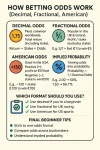- Joined
- Jul 11, 2008
- Messages
- 1,355
- Reaction score
- 174
- Points
- 63
This is for beginners who want to understand odds quickly, calculate payouts, convert between formats, and pick the best display for their betting style.
What Odds Actually Mean (One Simple Idea)
No matter the format, odds tell you two things: how much you win if you’re right, and what the market thinks the chance is. Higher odds = bigger payout but lower implied chance. Lower odds = smaller payout but higher implied chance. The format doesn’t change the bet, only how it’s displayed.Decimal Odds (Europe/Asia Standard)
Decimal odds are the simplest for beginners. They show your total return per 1 unit staked, including your stake. Example: 2.50 means you get 2.50 back for every 1 you bet. Profit is 1.50, stake returned is 1.00. Payout formula: stake × decimal odds = total return.Quick feel:
1.50 = strong favourite
2.00 = even-ish game
3.00+ = underdog
Implied probability: 1 / decimal odds. So 2.00 → 50%, 1.50 → 66.7%, 4.00 → 25%. This helps you judge whether the price is fair.
Fractional Odds (UK/Ireland Tradition)
Fractional odds show profit relative to stake. Example: 5/2 means you win 5 units profit for every 2 units staked. So a 10 stake returns 25 profit plus your 10 stake back = 35 total. The top number is profit, the bottom number is your stake ratio. Even money is often written as 1/1 (or “evens”).Implied probability for fractions: denominator / (numerator + denominator). Example: 5/2 → 2/(5+2)=2/7≈28.6%.
American Odds (US Sports Standard)
American odds use + and - signs around 100.+200 means you win 200 profit on a 100 stake.
-200 means you must stake 200 to win 100 profit.
Implied probability:
For +odds: 100 / (odds + 100). Example +150 → 100/250=40%.
For -odds: |odds| / (|odds| + 100). Example -150 → 150/250=60%.
Fast Conversion Cheat Sheet
You don’t need to memorise everything, just the basics:Decimal → Fractional: (decimal - 1) as a fraction. Example: 2.50 → 1.50 → 3/2.
Fractional → Decimal: (numerator / denominator) + 1. Example: 5/2 → 2.5 + 1 = 3.5.
American → Decimal:
+odds: (odds / 100) + 1. Example: +180 → 1.80 + 1 = 2.80.
-odds: (100 / |odds|) + 1. Example: -200 → 0.50 + 1 = 1.50.
Which Format Should You Use?
Use the format that makes you fastest and least emotional. Most beginners should start with decimal because payout and probability are obvious. Fractional is great if you grew up with UK/Irish betting culture, especially racing. American makes sense if you mostly bet US sports and think naturally in +/-. The good news is that major platforms like Pinnacle, Everygame, 1xBet, and MadMarket all let you switch odds format in settings, so you can use what feels natural without changing anything about your bets.Beginner Reality Check (Tiny Pre-Bet Routine)
Before placing any bet, do this quick check:- Can I explain why I like this bet in one sentence?
- Do the odds imply a chance lower than my honest estimate?
- Is the payout worth the risk, or am I just backing a favourite?
Common Odds Traps Beginners Fall Into
- Thinking low odds are “safe.” They’re only safe if the price is fair.
- Chasing big odds because the payout looks exciting. Value matters more than size.
- Mixing formats and getting confused mid-session. Pick one display and stick with it.
A good bet is not “the most likely winner.” A good bet is the best price relative to the real chance.
Putting It All Together
Odds are just different languages for the same message. Decimal shows total return, fractional shows profit ratio, American shows profit per 100 (or stake needed to win 100). Learn one format deeply, know how to convert the others, and always translate odds into probability in your head. Once you do that, you stop betting on teams and start betting on prices — which is the foundation of every serious bettor.FAQ
Q1: Do different odds formats change my winnings?A: No. The bet is identical; only the display changes.
Q2: What’s the easiest format for beginners?
A: Decimal odds, because payout and implied chance are most direct.
Q3: How do I know if odds are good value?
A: If your honest probability is higher than the implied probability from the odds, you have value.
Next in Beginner Series: How to Manage Your Bankroll (Beginner Edition)
Previous: Beginner Betting 101 – The Absolute Starter Guide
Attachments
Last edited:


